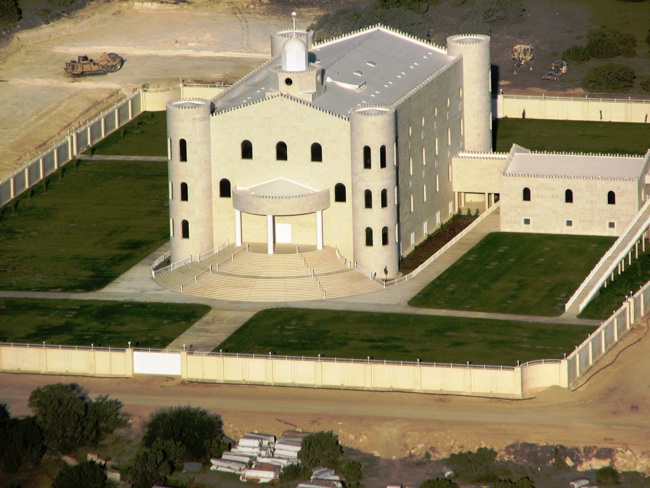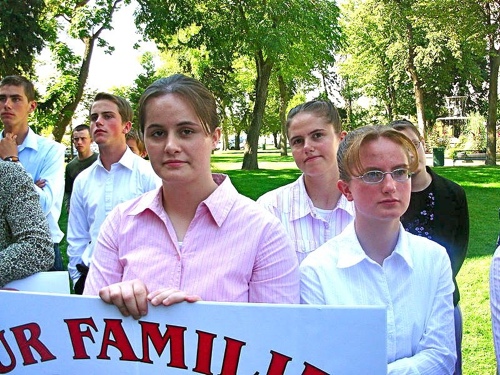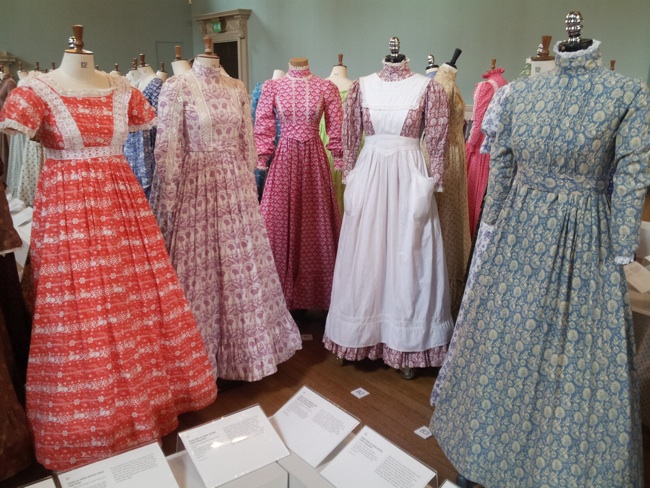
Kelly Baker
A couple of months ago, I started watching the first season of Unbreakable Kimmy Schmidt on Netflix. In the premiere episode, Kimmy and the three other “mole ladies” are rescued by a SWAT team from an underground bunker. A cult leader, the Reverend Richard Wayne Gary Wayne, kidnapped and imprisoned them for 15 years claiming to have saved them from the apocalypse. (Really, this is my kind of show, so I’m surprised I hadn’t watched it sooner). The four women climb out of the bunker and realize the world didn’t end after all. They are all wearing long, pastel dresses.
“Of course,” I said to my husband, “they’re wearing prairie dresses.”
The prairie dress remains one of the most visible markers of the Fundamentalist Church of Jesus Christ of Latter Day Saints (FLDS), in particular the Yearning for Zion (YFZ) ranch previously located outside of Eldorado, Texas. (The State of Texas seized the 1700-acre property in April of 2014.) Photographs of FLDS women wearing this type of dress with a high neckline, long sleeves, long skirt, and buttons in a variety of pastels appeared again and again in the news and popular culture. Watching Unbreakable Kimmy Schmidt reminded me of my longtime fascination with the prairie dress and its detractors. I’ve followed how the media describes and responds to FLDS fashion since the April 2008 raid on the YFZ compound by Texas law enforcement and child protective agencies. Authorities removed children from their parents and remanded them to state custody. I come back to the image of FLDS women loading their children onto a yellow school bus while law enforcement officers supervise.
Pastel dresses stand out starkly among the police uniforms.
The raid of the YFZ ranch started with a phone call to a domestic abuse hotline in late March of 2008. The caller claimed to be a sixteen year-old girl, Sarah, who was sexually and physically abused by her much older husband at the compound. Authorities later discovered the phone call was a hoax by a woman who had a long history of fake calls regarding abuse. This call provided the much-desired evidence for Texan authorities to enter the compound with SWAT teams, remove 437 children, and place them in state custody. The legal wrangling lasted until May when a Texas appeals court decided the raid had not met the burden of proof for the removal of the children. The State of Texas returned the children to their parents. Later, authorities were able to indict twelve male church members on charges ranging from bigamy to sex with a minor.

Photographs of the children and their young mothers appeared in major news magazines, websites, and blogs. News outlets bombarded viewers and listeners with titillating descriptions of polygamous families and life on the compound. Warren Jeffs, a former leader, already had achieved national notoriety after appearing on the FBI’s most wanted list with allegations of forcing minors into marriage. He’s currently serving a life sentence plus 20 years for sexual assault of two teenage girls. The news outlets, unsurprisingly, were skeptical of both polygamous marriage and the isolation from modern culture at the YFZ ranch. FLDS women with their braided hair and prairie dresses evoked the distance between life at the ranch and larger American culture.
The FLDS practice of polygamy generated much curiosity about the YFZ ranch while allegations of child abuse and child brides led to public outcry. Something interesting, however, happened within the media coverage. News outlets covered the forced removal of FLDS children from their parents, but soon began to critique the YFZ women’s fashion choices. At the Huffington Post, Verena von Pfetten asked, “Have you ever wondered what exactly the deal is with Fundamentalist Mormon hair and the Little House on the Prairie-esque dresses?”

Images of FLDS women commonly graced articles about the raid and the resulting legal battles. Their long-sleeved pastel dresses, elaborate braids, hand-rolled bangs, Skechers, and make-up free faces appeared as odd and out-of-sync with the current fashion trends. Their style appeared as a throwback to 19th century fashion. The mainstream media labeled FLDS fashion as prairie chic or polygamist fashion. Bloggers, editors and opinion writers all grappled with the pressing issue of how these women could wear such awful clothing. For a moment, fashion disaster appeared more pressing than child brides.
Critiquing the dress of FLDS women emerged as a method to demonstrate how this religious movement clearly did not fit within American culture. Instead of explicitly condemning the FLDS as a religious movement (which some news outlets did), condemning prairie dresses was a more subtle form of religious intolerance. Attacking fashion choices appeared frivolous and banal while it actually functioned to disparage the women who joined this new religious movement and FLDS more generally.
Polygamist fashion appeared homespun, exotic, and remarkable. Journalists, pundits, columnists, and bloggers wanted to know why 21st century women would choose to wear these “unattractive” dresses. Moreover, why would women dress so horribly?
To find some sort of an answer, The Early Show’s Julie Chen interviewed Carolyn Jessop, author of Escape and former FLDS adherent, in April of 2008. Jessop described dress as a means for social control, a reflection of the rigidity of the FLDS lifestyle. Dress created an image of the larger whole of FLDS while downplaying from the individuality of each woman. Jessop explained, “It’s a way to keep the women separated from everyone else…and it does affect your individuality and, you know, you’re not allowed free expression as far as what you’re allowed to wear.” Pastel dresses appeared as the physical representations of the limits placed on FLDS women. A columnist from The Salt Lake Tribune wrote, “The compound fence isn’t the only cage for the women of polygamy. There is also a prison uniform: yards of pink and blue fabric, inches and inches of hair, and ugly orthopedic shoes.”
Bad fashion was a form of social control.
Even Oprah attempted to figure out the appeal of polygamist fashion. In March of 2009, a little less than a year after the raid, Oprah interviewed teenage girls at the YFZ ranch about their clothing. She asked the girls if they knew about the media coverage of their fashion. But mostly, Oprah wanted to know why all the dresses looked alike. The girls affirmed that they covered their bodies because the body was sacred. One girl explained that the dresses are unique, but don’t seem different to outsiders. Oprah chuckled and replied, “Olive, that is funny!” Her laughter illustrated the common derision and skepticism about FLDS common among the mainstream media. Of course, the dresses look the same to Oprah; she hasn’t taken the time or effort to look at the clothing closely. For the YFZ women, the dresses are different colors with special stitching that makes them unique. To outsiders, the dresses appear homogenous and hideous, but for the teen girls Oprah interviewed the dresses expressed a distinct fashion choice that was supposed to be in opposition to the current fashion trends. Their fashion sense was their own, and it took time and labor to accomplish this particular style. Complicated braids, hand-rolling their bangs, and sewing and stitching dresses are all time-consuming activities. These women were complying with FLDS standards of beauty, which do not match neatly with our culture’s narrow conception of who can be beautiful.
In media accounts, YFZ fashion was problematic. It was an example of harmful institutional religion and the restriction on women’s choices and free expression. Ugly clothes and braids bound YFZ women to a possibly dangerous religious cult.
Robin Givhan, at the Washington Post, wrote, “It’s hard to look at the women from the polygamist compound in Texas and not be stopped by their studiously constructed appearance.” Their style, not quite runway ready, immediately sets FLDS women apart. Style, for Givhan and many others, becomes one of our most public expressions of our identities, and the FLDS women have surely created a public style. She describes their fashion:
With modesty as the apparent goal, the women have selected ankle-length prairie dresses with puffy shoulders, bishop sleeves and neatly buttoned collars. They have chosen colors that could be described as calling to mind the region’s wildflowers. But the effect is far less flattering. They look as though they are dressed in the washed-out hues of institutional garb, a bit like old-fashioned prison inmates (emphasis mine).
This prairie aesthetic appears purposefully antiquated and institutional. The dresses, then, signal a rejection of popular culture. She admits, unlike many of her counterparts, that this rejection is mostly sartorial since FLDS men, women, and children use cell phones and internet as well as buy comfortable modern footwear. Givhan points out the most interesting component of the media coverage of FLDS dress. She writes, “Of all things in modern society that could cause offense, it is curious that fashion ranks so high. Wouldn’t the incessant ringing of cell phones be more obnoxious than, say, a dress with a zipper?”
Despite her attempts to put the journalistic fashion frenzy in context, Givhan cannot reconcile 19th century garb as the only form of modesty available to the women of the YFZ ranch. Givhan argues that there are plenty of other clothing items that allow modesty: t-shirts, cardigans, turtlenecks, peasant shirts and skirts, and, of course, all-American blue jeans. Perhaps, the availability of other modest clothing is why the prairie dresses caused such uproar. Prairie dresses are clearly not the only way to make women’s bodies appear modest. No, polygamist fashion, instead, signaled something else about how news outlets wanted us to understand these women. Lack of style came to equal lack of intelligence, free will, and cultural savvy.
Bad fashion signals bad religion.
It is easy to dismiss fashion critique as a simple difference of opinion. This snarky critique works because it appears innocuous. What harm can be done by criticizing clothes? By attacking polygamist chic, the news media fed the image of exotic nature of FLDS and the danger lurking behind pastel dresses. Questioning fashion served to question the motives and mental well-being of the women of FLDS. For the media, these women might appear non-threatening, but their dress illuminated their ties to a harmful religious movement that abused children and women alike. Dresses and braids were signs of brainwashing and forced submission. After all, the raid did not successfully separate women and children from the Yearning for Zion ranch. Growing public recognition and discomfort about the questionable nature of the raid made it appear unsafe to attack FLDS beliefs and practices more directly. Attacking something as meaningless as “fashion” was an easy conduit for a larger attack on FLDS as a religious movement. The rhetoric surrounding polygamist fashion suggested that the raid was necessary to save these women and children from themselves, in spite of the shaky legality of the children’s forced removal.
The fashion policing of FLDS women, then, was also a method to critique women who belong to new religious movements for sacrificing their bodies, their minds, and their children to a “cult”. The burden fell squarely on the pastel shoulders of the YFZ women. The question of how they could sacrifice bodily appearance and composure went hand-in-hand with how they could believe in such a religion any way. Ridiculous fashion was a signal of the women’s own shortcomings to follow along with a religion that dictated polygamy and separation from society. Pastel dresses were sartorial traps. To discard polygamy fashion was to discard FLDS without being intolerant. For the news media, pointing out the exotic nature of dress also exposed the exotic and dangerous nature of this religion. What are they wearing easily became how can they believe this.
After all, fashionable intolerance was just about how we dressed, which isn’t really important. Is it?
Kelly J. Baker is a freelance writer with a Religious Studies PhD who covers higher education, gender, labor, motherhood, American religions, and popular culture. She is the author of Gospel According to the Klan: The KKK’s Appeal to Protestant America (2011) and The Zombies are Coming! (2013). She can be followed @kelly_j_baker.
